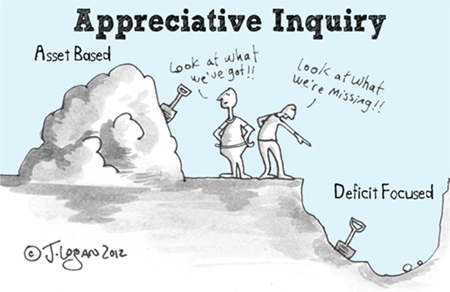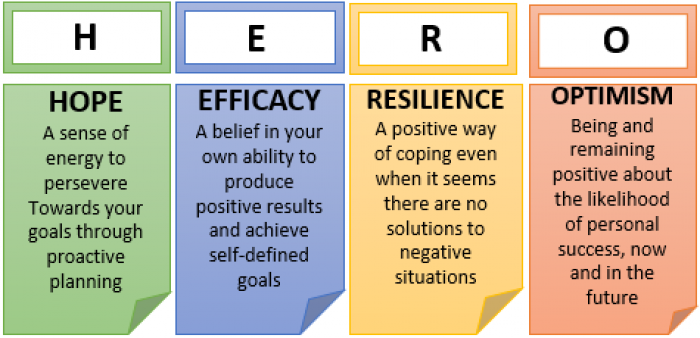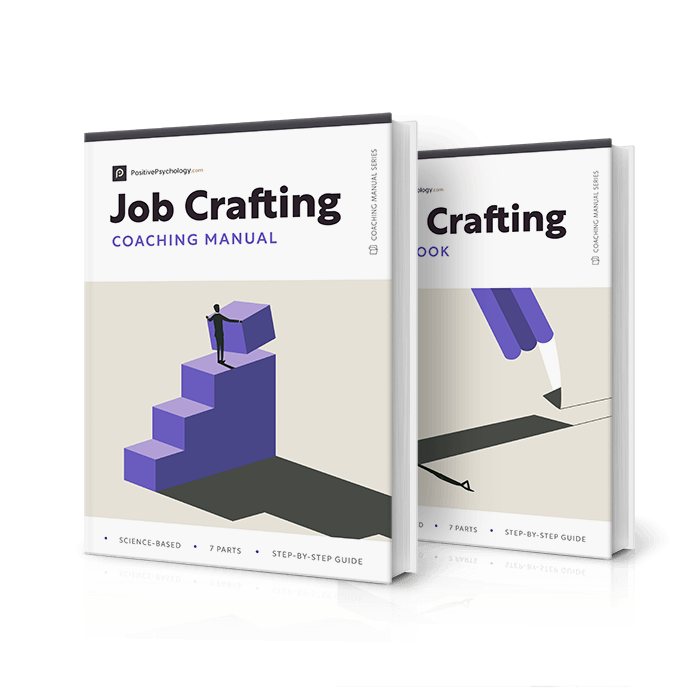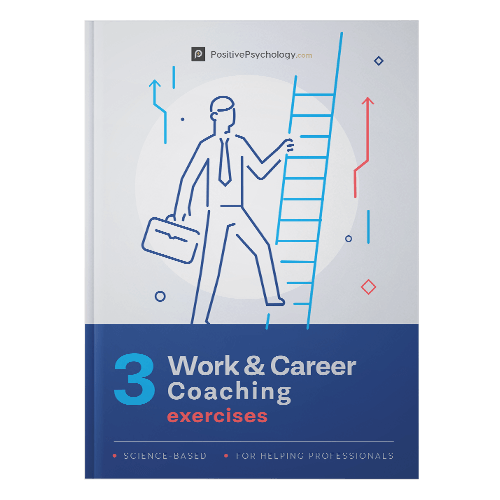What is Positive Organizational Psychology?
 Once upon a time, psychologists working in organizations were typically doing so in service of a firm’s bottom line.
Once upon a time, psychologists working in organizations were typically doing so in service of a firm’s bottom line.
Today, scholars, psychologists, and practitioners are aware of the impact that one’s working life can have on overall functioning and its importance for a fulfilling life.
The research space in which these potentials are explored is broadly known as Positive Organizational Psychology. Those working in this space, which unifies various approaches in organizational studies, aim to create and sustain work environments that support human potential, thriving, and individual and collective wellbeing.
In this article, we’ll summarize the key research streams that have emerged in the field of Positive Organizational Psychology and point you toward additional reading and materials to guide you if you wish to learn more.
Before you continue, we thought you might like to download our three Work & Career Coaching Exercises for free. These detailed, science-based exercises will help you or your clients identify opportunities for professional growth and create a more meaningful career.
This Article Contains:
- What is Positive Organizational Psychology? (Incl. Definition)
- Positive Work-Related Traits and Characteristics
- Strengths, Virtues and Appreciative Inquiry
- Positive Behaviors in Organizations
- Positive Emotions in Organizations
- Positive Outcomes in Organizational Psychology
- Work-Life Balance, Recovery and Resources
- 10 Books on Positive Organizational Psychology and Positive Leadership
- 9 Videos and TED Talks
- A Take-Home Message
- References
What is Positive Organizational Psychology? (Incl. Definition)
Positive Organizational Psychology asks questions about what goes right, what gives life, what inspires, and what is experienced as good (and bad) in organizations.
Positive organizational psychology is the scientific study of positive subjective experiences and traits in the workplace and positive organizations, and its application to improve the effectiveness and quality of life in organizations.
Donaldson & Ko, 2010
To expand on this definition, Positive Organizational Psychology attempts to identify motivations, enablers, and effects of positive organizational patterns so that we may find ways to capitalize on their existence.
Consequently, this new lens has answered questions regarding how to develop employee strengths, foster resilience, and bring healing to the work environment.
Much of what we know in this field stems from two closely related branches of Positive Organizational Psychology: Positive Organizational Behavior (Luthans, 2002) and Positive Organizational Scholarship (Cameron, Dutton, & Quinn, 2003).
Luthans (2002) defines Positive Organizational Behavior as:
The study and application of positively oriented human resource strengths and psychological capacities that can be measured, developed and managed for performance improvement in today’s workplace.
In contrast, Cameron and Caza’s (2004, p. 731) definition of Positive Organizational Psychology focuses more specifically on the aspects of organizations that help individuals thrive, defining the field as “the study of that which is positive, flourishing, and life-giving in organizations.”
While these two perspectives overlap, Positive Organizational Behavior typically focuses on the organizational benefits of employee wellbeing, while Positive Organizational Psychology stresses employee wellbeing as an end in itself.
Nonetheless, the aims of maximizing a business’ success and ensuring the wellbeing of workers are by no means incompatible. Many well-known organizations that implement systems to prioritize the health and wellbeing of its employees have been shown to prosper financially, including Volkswagen and Siemens (Zwetsloot & Pot, 2004).
In this article, we will focus primarily on the human side of positive experiences at work through the lens of Positive Organizational Psychology.
Positive Work-Related Traits and Characteristics
A common approach to studying positivity in organizations is to examine stable facets of the individual that can lead to desired outcomes, such as wellbeing and high performance.
There are innumerable work-related traits that play a role in the work environment. Here, we will explore three that have attracted some of the most attention among positive organizational psychologists: psychological capital, pro-social motivation, and positive work-related identities.
Psychological capital
The Oxford Handbook of Positive Organizational Scholarship (Cameron & Spreitzer, 2012) defines psychological capital (PsyCap) as an umbrella concept comprising four psychological resources:
- Confidence (or self-efficacy) to accept and put in the necessary effort to succeed at challenging tasks;
- Optimism about one’s likelihood of success now and in the future;
- Hope in the face of adversity when pursuing goals; and
- Resilience for facing problems and ‘bouncing back’ from adversity.
In work settings, interventions that can increase PsyCap include training and skill development to improve mastery of job-rated tasks, goal-setting, future-oriented thinking, and planning to address future obstacles and setbacks (Luthans, Youssef, & Avolio, 2007).
In contrast to more fleeting states, such as positive mood, PsyCap has been shown to remain fairly stable over time, suggesting that interventions to enhance PsyCap are likely to have significant positive benefits for organizations and their employees.
Indeed, one study found that the return on investment when developing an organization’s PsyCap can be as high as 200% (Luthans et al., 2007).
Prosocial motivation
Prosocial motivation refers to a person’s motivation to act for the benefit of others and with the intention of helping others (Grant & Berg, 2012).
While prosocial motivation is often conceptualized and examined as a global-level trait (i.e., a person’s tendency toward being motivated to help others in general), the concept also has relevance at the contextual and situational levels.
Regarding context, a person may exhibit a prosocial motivation to benefit a particular category of people, such as those in a specific role or department. Likewise, a person may exhibit prosocial motivation in specific situations, such as a nurse wishing to care for a particular patient or a receptionist who is in the mood to help her colleague on a particular day.
When accompanied by intrinsic motivation and trustworthy management, prosocial motivation has been shown to predict a range of desirable outcomes, including persistence, creativity, and performance (Grant, & Berg, 2012).
Prosocial motivation can also lead to organizational citizenship behaviors, which are the positive, constructive actions employees take that aren’t formally included in one’s job description (Organ, 1997). Such behaviors can include helping out a new colleague, volunteering to assist with additional projects, or sharing ideas with others (Grant, & Berg, 2012).
Positive work-related identity
Prosocial practices at work lead to the development of employees’ positive work-related identities and further contribute to a sense of flourishing. Indeed, given that many of us spend a third of our time at work, our sense of identity in this domain plays an important part in shaping our overall perception of who we are.
A key indicator of whether a person possesses a positive work-related identity is whether they perceive their job as a calling (Wrzesniewski, 2003). Other signs may be if an employee experiences intrinsic motivation when undertaking their job responsibilities or if behaviors are driven by identified or integrated regulation, suggesting a role is congruent with one’s values and sense of self.
Organizations can strengthen employees’ work-related identities by recognizing and helping staff to develop their strengths (Rothbard & Patil, 2012). This often means designing jobs to fit people rather than the other way around.
Further, when employees can see the end result of their work, such as when they are directly connected to the end-users of their products or services, they are more likely to understand why their role is meaningful and experience a more positive work-related identity (Hirschi, 2012).
It is important to acknowledge that the above are just three examples of positive work-related traits. There are many stable characteristics of a person that fall under the umbrella of Positive Organizational Psychology, and the list of these characteristics remains ever-growing as research continues to evolve.
Here are some other positive work-related traits you may wish to investigate (Barrick & Mount, 1991; Hirst, Yeo, Celestine, Lin & Richardson, 2020; Stajkovic & Luthans, 1998):
- Proactive personality;
- Core self-evaluations;
- Work-related self-efficacy;
- Goal orientation;
- Regulatory focus; and
- Extraversion.
Strengths, Virtues, and Appreciative Inquiry

Examples of strengths that have benefits in the workplace can include communication, creativity, and perseverance, but also others that we tend to think of as only being relevant in the personal domain, such as zest and love (Park & Peterson, 2009).
The benefits of considering employees’ unique strengths in organizations are two-fold.
Firstly, when employees are empowered to apply their strengths while at work, they will feel happier. This happiness has been shown to take the form of passion (i.e., strong feelings of inclination toward an activity that is loved; Vallerand et al., 2003), wellbeing, need-fulfillment, and vitality (Dubreuil, Forest, & Courcy, 2014; Forest et al., 2012; Govindji & Linley, 2007).
Employees who are regularly given opportunities to leverage their strengths will also feel more effective, thereby facilitating states of engagement and a sense of self-esteem (Costantini, Ceschi, Viragos, De Paola, & Sartori, 2019).
Secondly, the utilization of individual strengths in the workplace has been directly and indirectly linked to a range of outcomes that contribute to a firm’s bottom line, including goal progress, concentration, and overall work performance (Dubreuil et al., 2014; Linley, Nielsen, Gillett, & Biswas-Diener, 2010).
The process for effectively applying employee strengths in the organization is known as appreciative inquiry, and appreciative inquiry as a model for organizational change mirrors many of the strength-based approaches employed in the context of coaching.
In this context, the word ‘appreciative’ signals the practice’s focus on what people do well and opportunities in the environment rather than the more negative, deficit-based approach inherent in most organizational change models (Stavros & Wooten, 2012).
The benefits of such an approach are that it often generates more commitment and engagement to a change initiative as people feel more inclined to participate in discussions about what works than what doesn’t. Further, the process helps generate a shared vision of a desired future that employees can get excited about (AI Commons, n.d.).
Positive Behaviors in Organizations
Many of the positive outcomes that individual employees and managers desire in the work environment are facilitated by individual and collective behaviors. In this sense, work-related behaviors often mediate the relationship between features of a work environment, culture, or system and desired outcomes.
As an example, imagine a company where work is structured to allow employees a high degree of scheduling and decision-making autonomy. In this situation, it is unlikely to be the structure itself that leads to job satisfaction, but rather the behaviors that flow from this structure, such as taking regular work breaks and choosing tasks that align well with one’s interests.
In what follows, we consider job crafting and interpersonal behaviors as two such behaviors in organizations that can act as mediators of an organization’s more distal positive features.
Job crafting
Job crafting refers to “the physical and cognitive changes individuals make in the task or relational boundaries of their work” (Wrzesniewski & Dutton, 2001, p. 179). When job crafting, workers make adjustments to aspects of their job to help them better fit their needs.
A commonly shared and illustrative example of job crafting centers around a hypothetical member of a hospital’s cleaning staff.
Rather than perceiving the tasks involved in their job as simply being about wiping down surfaces and mopping floors, this employee may choose to job craft by consciously altering how they perceive their job–a process known as cognitive crafting. That is, they could choose to see their duties as critical for facilitating patients’ comfort and healthy recovery from illness.
Positive relationships and interpersonal behaviors
Unless you work entirely solo, positive relationships tend to be critical for a workplace to thrive. This remains true even with the rise of virtual work (Raghuram, Garud, Wiesenfeld, & Gupta, 2001).
Research in this area has matured such that while studies previously focused on dyadic relationships (i.e., those between two people), many now consider networks of relationships throughout an organization. Such approaches have only been made possible thanks to advancements in statistical modeling techniques (Knoke & Yang, 2019).
These approaches have enabled researchers to map out the strength and number of relationships within a team, department, or organization to better understand the flow of knowledge, reporting, helping behaviors, and more within a work environment.
From a psychological perspective, a range of subjective experiences, processes, and behaviors associated with work relationships have been examined in the literature, so we encourage you to look into those that may be of interest to you:
- Perspective-taking;
- Trust;
- Compassion;
- Relational coordination theory;
- Civility;
- Organizational citizenship behaviors;
- Humor;
- Psychological safety; and
- Authenticity.
Positive Emotions in Organizations
Research in Positive Organizational Psychology commonly explores the effects of positive emotional contagion in work settings, particularly when it flows from a firm’s leadership.
Emotional contagion refers to people’s tendency to mimic the emotions and expressions of others around them, usually without conscious effort (Barsade, 2002). Therefore, leaders, who are often in the spotlight, play a crucial role in generating positive emotions among staff.
Given that emotions are often transferred through the observation of non-verbal cues, an emotionally intelligent leader will remain conscious of this as they communicate with a team. That is, he or she will display the emotions they wish to see generated amongst their team, such as passion and enthusiasm, when delivering a rousing address.
Besides the obvious benefits of emotional contagion for inspiring commitment and enthusiasm within a team, it has been shown that experiencing a broad spectrum of positive emotions within a workplace can have more general benefits for wellbeing and performance.
In a seminal theory piece, Professor Barbara Fredrickson (1998) argued that the experience of positive emotions broadens a person’s thought-action repertoires, such that they can draw on a broader range of behavioral responses in particular situations. This becomes intuitive to understand when we consider what our minds and bodies do when we feel negative emotions.
When faced with negative emotions, our attention narrows, and we tend to draw on automatic, well-practiced behaviors to manage our situation, defend ourselves, and minimize displeasure or pain (Fredrickson, 1998). This response occurs, in part, because negative emotions tend to invoke specific thought-action tendencies.
For instance, when we feel fear, jealousy, or anxiety, there is typically a limited scope of behaviors we can draw on to address our situation, thereby limiting opportunities for creativity and experimentation.
In contrast, emotions like joy do not demand specific behavioral responses. Instead, they leave us free to experiment, have fun, and be creative. Consequently, these behaviors, and the diffuse foci attention they invoke, are likely to facilitate problem-solving, work engagement, teamwork, and other desirable behaviors and states (Diener, Thapa, & Tay, 2020).
Positive Outcomes in Organizational Psychology
It is the hope of positive organizational psychologists that by fostering nurturing work environments and developing people’s strengths, employees can experience a sense of flourishing and other positive states.
While there is a broad range of affective and wellbeing-related outcomes that may result from positive environments, traits, and behaviors, we briefly consider two that are commonly at the focus of Positive Organizational Scholarship: flow and work engagement.
Flow at work
Conceptualized by Professor Mihaly Csikszentmihalyi in 1975, flow refers to the feeling of being fully immersed in an activity.
When experiencing a flow state, attention does not wander, and you will often feel the passage of time to be moving very quickly (Csikszentmihalyi, 1990). Colloquially, the experience of flow is often described as the feeling that one is ‘in the zone.’
When experienced at work, flow stands to have a range of benefits for both individuals and organizations. One study found that the flow experience can foster upward cycles of personal and organizational resources (Salanova, Bakker, & Llorens, 2006). In this study, personal resources were conceptualized as self-efficacy, and organizational resources were conceptualized as social support and clear goals.
The results indicated that the more a person experiences flow in their work, the more they are likely to have access to said resources. This presence of resources was subsequently shown to facilitate more instances of flow, and the cycle continues (Salanova, Bakker, & Llorens, 2006).
These findings highlight the importance of designing work that removes barriers to the experience of flow so that employees can make the most of the resources in their environment.
Work engagement
Work engagement is defined as a “positive, fulfilling, work-related state of mind that is characterized by vigor, dedication, and absorption (Schaufeli, Salanova, González-Romá, & Bakker, 2002, p. 74).
As a trait, those who consistently exhibit high engagement are energetic, self-efficacious, and find ways to experience fun through their work (Bakker, 2009; Gorgievski, Bakker, & Schaufeli, 2010).
However, levels of work engagement have been shown to fluctuate within a person’s day, meaning that managers can play an active role in facilitating workers’ engagement (Venz, Pundt, & Sonnentag, 2018).
For instance, factors that can drive work engagement include job resources, such as autonomy, and personal resources, such as social support (Lesener, Gusy, Jochmann, & Wolter, 2020). These resources can flow on to enable employees to engage in desirable behaviors, such as job crafting behaviors, which can help employees strengthen their own engagement (Tims, Bakker, Derks, & Van Rhenen, 2013).
Ultimately, the benefits of a highly engaged workforce are two-fold. First, employees who are engaged will inherently experience more intrinsic motivation and enjoyment in their work, which has been shown to benefit wellbeing (Rothmann, 2008).
Secondly, those who exhibit high levels of engagement tend to perform better at their jobs across a range of indicators. For instance, engaged employees tend to be more innovative and exhibit better performance relating to duties that fall within and outside their formal job role (Demerouti & Cropanzano, 2010).
Overall, it is clear there are mutual gains for both employees and organizations when a work environment facilitates flow and work engagement. The study of Positive Organizational Psychology can help us recognize these opportunities.
In addition to these two outcomes, Positive Organizational Scholarship tends to focus on a broad subset of outcomes indicative of individual and collective wellbeing at work; the field remains ever-growing.
Other outcomes you may wish to investigate include:
- Energy;
- Moral capital;
- Inspiration;
- Elevation;
- Work meaningfulness;
- Thriving;
- Vitality; and
- Flourishing
Work-Life Balance, Recovery and Resources
Whether we are investing our time and energy in personal pursuits or work tasks, we all draw from the same well of internal resources. This is why, if we are to paint a complete picture of Positive Organizational Psychology, it is important to consider the interplay between one’s work and personal life.
The term ‘work-life balance’ remains ill-defined in the literature. However, it is generally used to refer to the degree of satisfaction or absence of conflicting demands between one’s responsibilities at work and in the home (Kalliath & Brough, 2008).
Key to facilitating sufficient work-life balance is ensuring that one has sufficient recovery from work demands. Recovery, in this context, refers to a process through which the body’s internal systems that have been drawn upon in demanding situations return to their prestressor levels (Sonnentag & Fritz, 2007).
Employees can promote their recovery through a range of activities like going for a light walk, socializing with friends, or engaging in hobbies. Consequently, these activities can facilitate a range of psychological recovery experiences that replenish resources, including psychological detachment from work and relaxation (Sonnentag & Fritz, 2007).
At the core of recovery theory (and most competing theories) is the view that employees possess internal pools of resources that must be periodically replenished after facing work demands (Feldman, 2004).
By regularly resting and replenishing our resources in this way, we remain able to do our jobs effectively and enjoy a healthy sense of wellbeing, rather than suffering from burnout, strain, and other negative states (Sonnentag & Fritz, 2007).
10 Books on Positive Organizational Psychology and Positive Leadership
In an effort to disseminate learnings from research to practitioners, many authors and scholars have published books and chapters on several of the topics explored here.
We’ve compiled a list of ten of our favorites for you here:
- How to Be a Positive Leader: Small Actions, Big Impact by Jane Dutton and Gretchen Spreitzer (Amazon)
- The Oxford Handbook of Positive Organizational Scholarship by Kim Cameron and Gretchen Spreitzer (Amazon)
- The Oxford Handbook of Positive Psychology and Work by P. Alex Linley, Susan Harrington and Nicola Garcea (Amazon)
- Positive Leadership: Strategies for Extraordinary Performance by Kim Cameron (Amazon)
- Advances in Positive Organizational Psychology by Arnold B Bakker (Amazon)
- The Appreciative Inquiry Handbook: For Leaders of Change Paperback by David L. Cooperrider (Amazon)
- Conscious Capitalism: Liberating the Heroic Spirit of Business by John Mackey, Rai Sisodia and Bill George (Amazon)
- The Wiley Blackwell Handbook of the Psychology of Positivity and Strengths-Based Approaches at Work by Lindsay G. Oades, Michael Steger, Antonelle Delle Fave, and Jonathan Passmore (Amazon)
- The Best Place to Work: The Art and Science of Creating an Extraordinary Workplace by Ron Friedman Ph.D.(Amazon)
- The Culture Code: The Secrets of Highly Successful Groups by Daniel Coyle (Amazon)
8 Videos and TED Talks
If you’re looking for more ways to share the message of Positive Organizational Psychology with your clients, take a look at some of the following videos and TEDTalks:
1. The Happy Secret to Better Work
In this engaging talk from TEDxBloomington, psychologist Shawn Achor argues that the secret to productivity at work may lie in the experience of happiness.
2. The Social Brain and its Superpowers
Neuroscientist Matthew Lieberman discusses how we can build on our social intuition to make ourselves smarter, happier, and more productive in this TEDx talk.
3. The Progress Principle
Drawing from her book The Progress Principle, Professor Teresa Amabile explores how companies can overcome the ‘crisis of disengagement’ in the workplace.
4. The Power of Leading Quietly
In this talk, presented at Wharton University, Professor Adam Grant discusses the dangers that may arise when extroverted personalities dominate in leadership roles.
5. Getting Stuck in the Negatives (and how to get unstuck)
Drawing from her research findings, Dr. Alison Ledgerwood explores our inherent bias toward negative thinking and asks how we might help ourselves to ‘think better’.
6. Grit: The Power of Passion and Perseverance
After leaving a prestigious job in consulting, Professor Angela Duckworth began teaching math to seventh graders in a New York public school. In this talk, Duckworth describes the role of grit as the key determinant of whether her students struggled or succeeded in their education and explores how all of us can benefit from this unique form of perseverance.
7. The Power of Yet
In this TEDx talk, Professor Carol Dweck explores how our perspective of goals and source of motivation affects our perception of success and our resilience in the face of setbacks.
8. Mindful Leadership, Health and the Power of Possibility
(Ellen is well known for her work on mindless and mindfulness)
Drawing on findings from research, Harvard University Professor Ellen Langer explores the dangers of living on autopilot, positioning mindfulness as the cure for individual and group suffering and the key to effective leadership.
A Take-Home Message
We spend a third of our lives at work.
You can think of Positive Organizational Psychology as the field of study that is trying to make that third of our time worth living.
Throughout this article, we’ve maintained a high-level focus as we’ve walked you through a range of topics explored by positive organizational psychologists, but there is plenty more to learn.
Whether you’re a consultant, manager, or researcher yourself, we encourage you to find an area of interest to you and dig further. We also encourage you to think about the core message of
Positive Organizational Psychology and see whether you can implement a small change in your own working life in an effort to prioritize your own wellbeing and happiness.
Let us know what change you decide to make. We’d love to hear from you in the comments!
We hope you enjoyed reading this article. Don’t forget to download our three Work & Career Coaching Exercises for free.
- AI Commons. (n.d.). Introduction to appreciative inquiry. Retrieved from https://appreciativeinquiry.champlain.edu/learn/appreciative-inquiry-introduction/
- Appreciative inquiry [Image] (2012). Retrieved from http://blogs.oregonstate.edu/programevaluation/2015/12/29/appreciative-inquiry/
- Bakker, A. B. (2009). Building engagement in the workplace. In R. J. Burke & C. L. Cooper (Eds.), The peak performing organization (pp. 50–72). Abingdon, UK: Routledge.
- Barrick, M. R., & Mount, M. K. (1991). The big five personality dimensions and job performance: a meta‐analysis. Personnel Psychology, 44(1), 1-26.
- Barsade, S. G. (2002). The ripple effect: Emotional contagion and its influence on group behavior. Administrative Science Quarterly, 47(4), 644-675.
- Cameron, K., & Caza, A. (2004). Introduction: Contributions to the discipline of positive organizational scholarship. American Behavioral Scientist, 47(6), 731-739.
- Cameron, K., Dutton, J. E., & Quinn, R. E. (2003). Positive organizational scholarship: Foundations of a new discipline. San Francisco, CA: Berrett-Koehler Publishers.
- Cameron, K. G., & Spreitzer, G. M. (2012). The Oxford handbook of positive organizational scholarship. New York, NY: Oxford University Press.
- Costantini, A., Ceschi, A., Viragos, A., De Paola, F., & Sartori, R. (2019). The role of a new strength-based intervention on organisation-based self-esteem and work engagement. Journal of Workplace Learning, 31(3), 194-206.
- Csikszentmihalyi, M. (1990). Flow: The psychology of optimal experience. New York, NY: HarperCollins.
- Demerouti, E., & Cropanzano, R. (2010). From thought to action: Employee work engagement and job performance. In A. B. Bakker & M. P. Leiter (Eds.), Work engagement: A handbook of essential theory and research (pp. 174-163). New York, NY: Psychology Press.
- Diener, E., Thapa, S., & Tay, L. (2020). Positive emotions at work. Annual Review of Organizational Psychology and Organizational Behavior, 7, 451-477.
- Donaldson, S. I., & Ko, I. (2010). Positive organizational psychology, behavior, and scholarship: A review of the emerging literature and evidence base. The Journal of Positive Psychology, 5(3), 177-191.
- Drucker, P. F. (2006). The effective executive: The definitive guide to getting the right things done. New York, NY: Collins.
- Dubreuil, P., Forest, J., & Courcy, F. (2014). From strengths use to work performance: The role of harmonious passion, subjective vitality, and concentration. The Journal of Positive Psychology, 9(4), 335-349.
- Feldman, M. S. (2004). Resources in emerging structures and processes of change. Organization Science, 15(3), 295-309.
- Forest, J., Mageau, G. A., Crevier-Braud, L., Bergeron, É., Dubreuil, P., & Lavigne, G. L. (2012). Harmonious passion as an explanation of the relation between signature strengths’ use and well-being at work: Test of an intervention program. Human Relations, 65(9), 1233-1252.
- Fredrickson, B. L. (1998). What good are positive emotions? Review of General Psychology, 2(3), 300-319.
- Govindji, R., & Linley, P. A. (2007). Strengths use, self-concordance and well-being: Implications for strengths coaching and coaching psychologists. International Coaching Psychology Review, 2(2), 143-153.
- HERO acronym [Image] (n.d.). Retrieved from https://www.thepositiveacademy.net/en/kurzy/professional-development/230/psychological-capital.html
- Gorgievski, M. J., Bakker, A. B., & Schaufeli, W. B. (2010). Work engagement and workaholism: Comparing the self-employed and salaried employees. The Journal of Positive Psychology, 5(1), 83-96.
- Grant, A. M., & Berg, J. M. (2012). Prosocial motivation. In K. Cameron & G. M. Spreitzer (Eds.), The Oxford handbook of positive organizational scholarship (pp. 28-44). New York, NY: Oxford University Press.
- Hirschi, A. (2012). Callings and work engagement: Moderated mediation model of work meaningfulness, occupational identity, and occupational self-efficacy. Journal of Counseling Psychology, 59(3), 479-485.
- Hirst, G., Yeo, G., Celestine, N., Lin, S. Y., & Richardson, A. (2020). It’s not just action but also about reflection: Taking stock of agency research to develop a future research agenda. Australian Journal of Management, 45(3), 376-401.
- Kalliath, T., & Brough, P. (2008). Work-life balance: A review of the meaning of the balance construct. Journal of Management & Organization, 14(3), 323-327.
- Knoke, D., & Yang, S. (2019). Social network analysis (3rd ed.). Thousand Oaks, CA: Sage.
- Lesener, T., Gusy, B., Jochmann, A., & Wolter, C. (2020). The drivers of work engagement: A meta-analytic review of longitudinal evidence. Work & Stress, 34(3), 259-278.
- Linley, P. A., Nielsen, K. M., Gillett, R., & Biswas-Diener, R. (2010). Using signature strengths in pursuit of goals: Effects on goal progress, need satisfaction, and well-being, and implications for coaching psychologists. International Coaching Psychology Review, 5(1), 6-15.
- Luthans, F. (2002). The need for and meaning of positive organizational behavior. Journal of Organizational Behavior: The International Journal of Industrial, Occupational and Organizational Psychology and Behavior, 23(6), 695-706.
- Luthans, F., Youssef, C. M., & Avolio, B. J. (2007). Psychological capital: Developing the human competitive edge. New York, NY: Oxford University Press.
- Meyers, M. C., van Woerkom, M., & Bakker, A. B. (2013). The added value of the positive: A literature review of positive psychology interventions in organizations. European Journal of Work and Organizational Psychology, 22(5), 618-632.
- Organ, D. W. (1997). Organizational citizenship behavior: It’s construct clean-up time. Human Performance, 10(2), 85-97.
- Park, N., & Peterson, C. (2009). Character strengths: Research and practice. Journal of College and Character, 10(4), 1-8.
- Raghuram, S., Garud, R., Wiesenfeld, B., & Gupta, V. (2001). Factors contributing to virtual work adjustment. Journal of Management, 27(3), 383-405.
- Rothbard, N. P., & Patil, S. V. (2012). Being there: Work engagement and positive organizational psychology. In K. Cameron & G. M. Spreitzer (Eds.), The Oxford handbook of positive organizational scholarship (pp. 231-243). New York, NY: Oxford University Press.
- Rothmann, S. (2008). Job satisfaction, occupational stress, burnout and work engagement as components of work-related wellbeing. SA Journal of Industrial Psychology, 34(3), 11-16.
- Salanova, M., Bakker, A. B., & Llorens, S. (2006). Flow at work: Evidence for an upward spiral of personal and organizational resources. Journal of Happiness studies, 7(1), 1-22.
- Schaufeli, W. B., Salanova, M., González-Romá, V., & Bakker, A. B. (2002). The measurement of engagement and burnout: A two sample confirmatory factor analytic approach. Journal of Happiness Studies, 3(1), 71-92.
- Sonnentag, S., & Fritz, C. (2007). The Recovery Experience Questionnaire: development and validation of a measure for assessing recuperation and unwinding from work. Journal of Occupational Health Psychology, 12(3), 204-221.
- Stajkovic, A. D., & Luthans, F. (1998). Self-efficacy and work-related performance: A meta-analysis. Psychological Bulletin, 124(2), 240-261.
- Stavros, J., & Wooten, L. (2012). Positive strategy: Creating and sustaining strengths-based strategy that SOARs and performs. In K. Cameron & G. M. Spreitzer (Eds.), The Oxford handbook of positive organizational scholarship (pp. 823-845). New York, NY: Oxford University Press.
- Tims, M., Bakker, A. B., Derks, D., & Van Rhenen, W. (2013). Job crafting at the team and individual level: Implications for work engagement and performance. Group & Organization Management, 38(4), 427-454.
- Vallerand, R. J., Blanchard, C., Mageau, G. A., Koestner, R., Ratelle, C., Léonard, M., … & Marsolais, J. (2003). Les passions de l’ame: On obsessive and harmonious passion. Journal of Personality and Social Psychology, 85(4), 756-767.
- Venz, L., Pundt, A., & Sonnentag, S. (2018). What matters for work engagement? A diary study on resources and the benefits of selective optimization with compensation for state work engagement. Journal of Organizational Behavior, 39(1), 26-38.
- Wrzesniewski, A. N. (2003). Finding positive meaning in work. In K. Cameron, J. E. Dutton & R. E. Quinn (Eds.), Positive organizational scholarship: Foundations of a new discipline. San Francisco, CA: Berrett-Koehler Publishers.
- Wrzesniewski, A., & Dutton, J. E. (2001). Crafting a job: Revisioning employees as active crafters of their work. Academy of Management Review, 26(2), 179-201.
- Zwetsloot, G., & Pot, F. (2004). The business value of health management. Journal of Business Ethics, 55(2), 115-124.
Let us know your thoughts
Read other articles by their category
- Body & Brain (49)
- Coaching & Application (57)
- Compassion (26)
- Counseling (51)
- Emotional Intelligence (24)
- Gratitude (18)
- Grief & Bereavement (21)
- Happiness & SWB (40)
- Meaning & Values (26)
- Meditation (20)
- Mindfulness (45)
- Motivation & Goals (45)
- Optimism & Mindset (34)
- Positive CBT (28)
- Positive Communication (20)
- Positive Education (47)
- Positive Emotions (32)
- Positive Leadership (18)
- Positive Parenting (4)
- Positive Psychology (33)
- Positive Workplace (37)
- Productivity (16)
- Relationships (46)
- Resilience & Coping (36)
- Self Awareness (21)
- Self Esteem (38)
- Strengths & Virtues (31)
- Stress & Burnout Prevention (34)
- Theory & Books (46)
- Therapy Exercises (37)
- Types of Therapy (64)






What our readers think
An amazing article so complete and extremely well researched thank you so much.
Very, very complete and useful. Thanks a lot
The best article I have read here on https://positivepsychology.com/
A heartfelt thank you.
Are there any courses or MSc specifically focused on positive organisational Psychology?
Hi Lola
You may have to follow some of the links posted in our article Positive Psychology Degree: 13 Opportunities for Eager Students. We do mention an MSc course or two in Applied Positive Psychology, but these might lead you in the right direction.
This is an awesome resource, thank you!
What a lovely overview, with handy references.
Thank you!